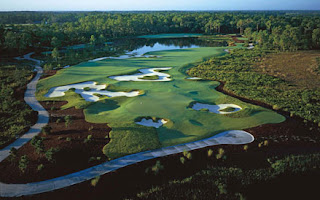 The Concession’s 349-yard, dogleg-left 12th is designed to be a reachable par 4 from any set of tees.
The Concession’s 349-yard, dogleg-left 12th is designed to be a reachable par 4 from any set of tees.
By Ron Whitten Photo By Stephen Szurlej for Golf Digest
ANOTHER CONCESSION
The concept began in 2002, when British-golf-hero-turned-Sarasota-resident Tony Jacklin read that developer Kevin Daves was planning a Jack Nicklaus-designed course in the area. Jacklin, champion of the 1969 British Open and 1970 U.S. Open and four-time European Ryder Cup captain, called Daves and said he wanted to be involved. Over a subsequent lunch, Jacklin suggested the club might have a Ryder Cup theme and gave Daves a photo for the clubhouse. It depicted Jacklin and Nicklaus in 1969, moments after Jack had conceded a par putt to Tony that resulted in the first tie in the history of the Ryder Cup.
Daves saw more than a photo. He saw a marketing scheme. He’d call his course The Concession. He’d use a silhouette of the photo as his logo. He’d have Jacklin work with Jack on the project.
Daves and Jacklin met with Nicklaus. Tony said he didn’t want to interfere with Jack’s design, but Jack replied, “No, if we’re going to do this, we’re going to do it together,” then winked: “I’ll concede once again.”
So it is that Jack Nicklaus and Tony Jacklin are sharing a trophy once more, this time as co-designers of The Concession Golf Club, America’s Best New Private Course of 2006. For Nicklaus, it’s the sixth time since 1984 that one of his course designs has been recognized by Golf Digest as a Best New winner. For Jacklin, who has only dabbled in course architecture, it’s a new honor. (His best-known previous work, a collaboration with former Ryder Cup teammate Dave Thomas, is San Roque Golf Club in Spain, just down the highway from 1997 Ryder Cup host Valderrama.)
The Concession is a course of remarkable beauty and isolation. Intended as the centerpiece of a 1,200-acre gated community, the course is actually off to the side, well away from back yards, spread over 540 acres of pines that reach as high as 150 feet and twisted oaks thought to be more than 200 years old. (If some specimens seem particularly strategic, that’s because more than $700,000 was spent transplanting 65 live oaks and 15 slash pines on certain holes.)
Jacklin would like the PGA of America to consider The Concession for a future Ryder Cup. (The earliest available date would be the 2024 matches.) It’s certainly a worthy test of championship golf, at 7,470 yards, par 72 from the tips, its Slope Rating of 155 tied for the highest of any course in Florida. All four of its par 3s face different directions, as do the four par 5s. There are an equal number of holes that bend left versus right. Its bright-white bunkers are big and flashy, most edged in thick-bladed Bahia grass to add a visual contrast to the hybrid Bermuda fairways and greens.
A dozen water hazards legitimately come into play, with four on the closing four holes posing the ultimate in risk-reward excitement. But the most intriguing hazard is narrow, man-made Tortoise Creek, which winds around the front, right and back of the tiny green on the nifty, narrow, 374-yard, dogleg-right eighth. It’s a hazard, and a hole, that Jacklin played a major role in creating.
What really sets The Concession apart are its greens. Several are perched above fairways, with steep dropoffs on one side or the other, and the one on the par-4 10th is at ground level, flowing from front to back. But the real departures from the Nicklaus mold are the movements within the greens. Instead of outside mounds extending into greens to create shelves and slopes, Nicklaus developed The Concession’s greens with contours that originate from within the putting surfaces and ripple outward, leaving most collars relatively flat. It’s a technique he says he learned while teaming with Tom Doak on Sebonack Golf Club in New York. Which proves you can teach a top dog new tricks.
Few people recall all the details of the Ryder Cup at England’s Royal Birkdale that precipitated this commemorative club. Back in 1969, there were two sessions of singles matches on the last day. Jacklin beat Nicklaus, 4 and 3, in the morning round, and in the afternoon Tony holed a 50-foot eagle putt on the 17th to square the only match remaining on the course. At 18, Nicklaus had a 15-footer to win but raced the putt four feet past. He made the comebacker, then picked up Tony’s coin, some two feet from the cup. U.S. captain Sam Snead and several of Jack’s teammates weren’t happy about Nicklaus’ magnanimity, but Jack shrugged it off. Jacklin was the reigning British Open champ, a hero to the home crowd. Jack didn’t want him to miss the putt and become a goat. Besides, under Ryder Cup rules, as defending champion, the U.S. retained possession of the Cup with the tie.
So maybe the concession wasn’t that big a deal after all. But The Concession is. As the best among America’s new private courses, it is also among the best of Nicklaus’ 250 designs, and already one of the finest in Florida. Given additional scrutiny,
The Concession might someday prove to be one of America’s 100 Greatest Golf Courses.




